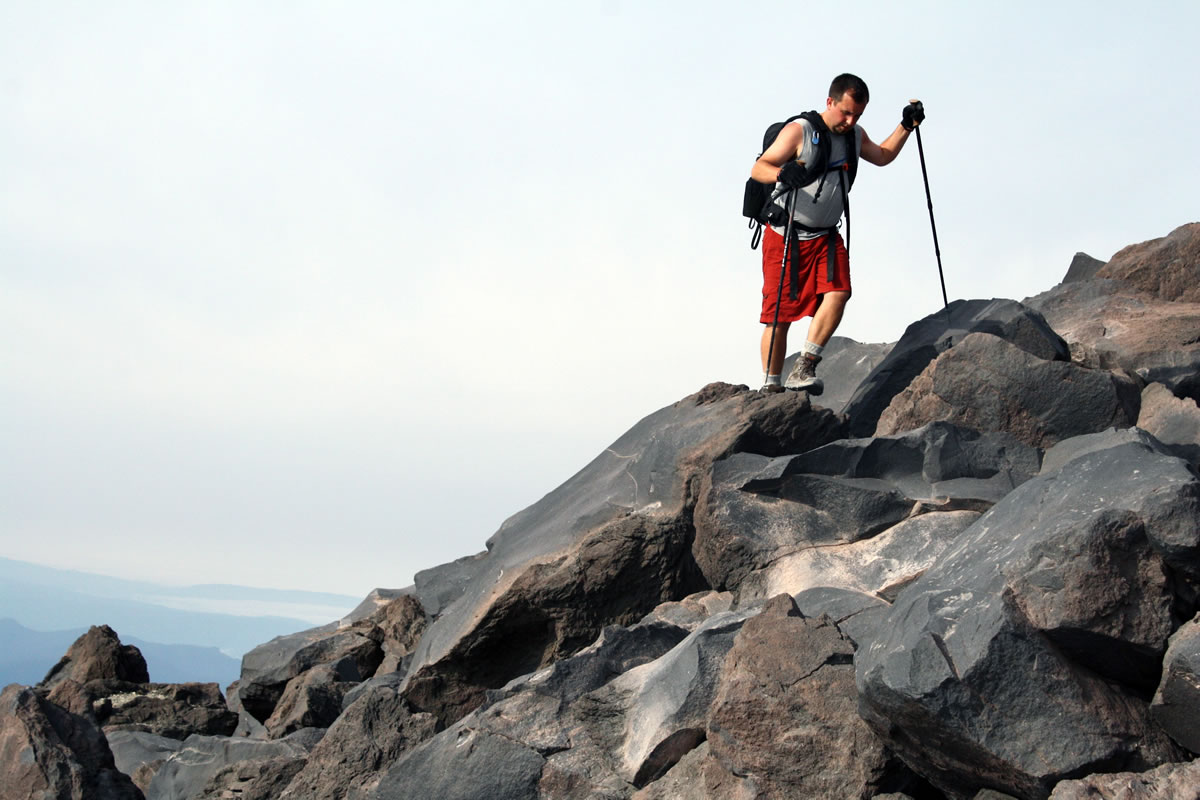COUGAR — Perched on the crater rim of Mount St. Helens for the second time in three weeks, Bryan Zagar marveled at the difference a few weeks could make on the 8,363-foot volcano.
“Two weeks ago there was a snowfield right here,” the Puyallup resident said, pointing at an ashy saddle between two humps on the crater rim. “My daughter was a little nervous when she crossed it.”
From the same spot on his first trip, Zagar and his kids couldn’t even see into the crater because their view was blocked by massive snow cornices.
On his second trip, July 31, he was enjoying an unobstructed view of St. Helens’ new dome and the Crater Glacier.
“It’s pretty amazing,” Zagar said.
Choosing the best time to hike to the top of Mount St. Helens is a matter of personal preference. And every trip has the potential to be different.
Some choose the winter for a “full-on mountaineering experience,” climbing ranger Heather Latham said. Some choose early spring and early summer so they can hike over snow without having to endure winter conditions.
Hiking the mountain in the snow not only allows climbers to take more direct routes and avoid long stretches of scrambling over boulders, but they also can ride down on skis or snowboards.
Other climbers like to wait until August, September and October when much of the snow has melted. “It’s more of a dusty scramble,” Latham said. “Some people just feel more comfortable off of the snow.”
Hiking in October has an added benefit of being the time of year when a $22 permit is easiest to acquire.
“It can be rainy and cloudy in the fall, which isn’t the best if you are climbing for the views,” Latham said. “But you are going to have a lot fewer people on the route and some people like that.”
Permits
Standing at Climbers Bivouac, the trailhead for the most popular St. Helens climbing route, the task of hiking up the volcano can seem daunting.
The grey and white slopes of the mountain look impossibly steep and the summit might seem too far to reach in just one morning.
But many who’ve hiked to the top say the hardest part is getting a permit. Of course, most of the people saying this do so well after their 5-mile, 4,500-vertical-feet climb is complete. Memories of sweeping above-the-cloud views last far longer than sore legs.
Mount St. Helens National Volcanic Monument limits the number of climbing permits issued to 100 per day from May 15-Oct. 31, and almost every summer day sells out.
When the permits go on sale each winter on the Mount St. Helens Institute website, it’s not uncommon for most weekend passes to sell out in a matter of hours. July and August permits also go quickly. September passes take longer to sell. As of Aug. 28, there were still 22 permits available.
For those who miss out on the initial rush to get a permit, September and October are ideal times to sneak in a trip.
The institute offers guided climbs in September for $175, although they often sell out too. Climbers who have decided not to hike the mountain in September resell their permits at purmit.com.
And if you don’t mind a higher chance of cold, cloudy weather, there are more than 2,000 permits available for October.
Know the route
It’s the search for places to glissade that leads to an increase in lost hikers on St. Helens late in the season, Latham said. While much of the snow melts in the summer, there is snow on the mountain all year.
“People tend to go to the snow on the way down and that can take them away from the route,” Latham said. “Sometimes they don’t realize how far they’ve gone as they glissade through different gullies. Then they call for help.”
Help can’t always arrive quickly, Latham said. Once climbers call for help, the Skamania County Sheriff’s department dispatches its volunteer Volcano Rescue Team.
Rescues can last into the night, she said.
To avoid this fate, Latham recommends climbers carry a map, compass and GPS and always be aware of where they are in relation to the route. Rangers have marked the climbing route on Monitor Ridge with posts wedged into the rocks. But in poor weather it can sometimes be hard to see from one post to the next.
“The weather can change quickly on the mountain, and you can get all kinds of weather,” Latham said. “It’s important to be prepared.”



